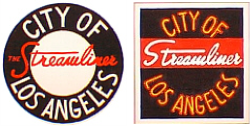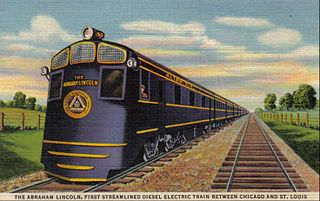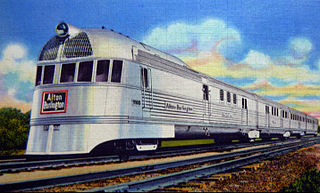
The Super Chief was one of the named passenger trains and the flagship of the Atchison, Topeka and Santa Fe Railway. The then-modern streamliner was touted in its heyday as "The Train of the Stars" because it often carried celebrities between Chicago, Illinois, and Los Angeles, California.

The City of Denver was a streamlined passenger train operated by the Union Pacific Railroad between Chicago, Illinois, and Denver, Colorado. It operated between 1936 and 1971. From 1936–1955 the Chicago and North Western Railway handled the train east of Omaha, Nebraska; the Chicago, Milwaukee, St. Paul and Pacific Railroad handled it thereafter. The train was the fastest long-distance train in the United States when it debuted in 1936, covering 1,048 miles (1,687 km) in 16 hours. For almost its entire career its principal competitor was the Chicago, Burlington and Quincy Railroad's Denver Zephyr. When Amtrak assumed operation of most intercity trains in the United States in 1971, it discontinued the City of Denver, preferring to use the Burlington's route between Chicago and Denver.

The City of Los Angeles was a streamlined passenger train between Chicago, Illinois, and Los Angeles, California via Omaha, Nebraska, and Ogden, Utah. Between Omaha and Los Angeles it ran on the Union Pacific Railroad; east of Omaha it ran on the Chicago and North Western Railway until October 1955 and on the Milwaukee Road thereafter. The train had number 103 westbound and number 104 eastbound.

The General Pershing Zephyr was the ninth of the Chicago, Burlington & Quincy Railroad's Zephyr streamliners, and the last built as an integrated streamliner rather than a train hauled by an EMD E-unit diesel locomotive. It was constructed in 1939 with bodywork and passenger cars by Budd Company and diesel engine, electric transmission, power truck, and other locomotive equipment by General Motors Electro-Motive Corporation. Because its intended Kansas City to St Louis route passed near the birthplace and boyhood home of famous World War I General John J. Pershing, the train was named after him. The power car was named Silver Charger, after Pershing's horse Charger, while the passenger cars were named after United States Army badges of rank—Silver Leaf, Silver Eagle, and Silver Star.

The Union Pacific Railroad's M-10001 was a diesel-electric streamlined train built in 1934 by Pullman-Standard with a power system developed by General Motors Electro-Motive Corporation using a Winton 201A Diesel engine and General Electric generator, control equipment and traction motors. It was the UP's second streamliner after the M-10000, their first equipped with a diesel engine and was a longer train than its three-car predecessor. All cars were articulated—trucks were shared between each car. It was delivered on October 2, 1934, and was used for display, test and record-setting runs for the next two months before being returned to Pullman-Standard for an increase in power and capacity, following which it was placed into service as the City of Portland train. It has been nicknamed "The Banana".

The Nebraska Zephyr was a streamlined passenger train operated by the Chicago, Burlington and Quincy Railroad between Chicago, Illinois; Omaha, Nebraska; and Lincoln, Nebraska, from 1947 to 1971. Until 1968, the service was provided by two Twin Cities Zephyr articulated trainsets — the "Train of the Gods" and "Train of the Goddesses" — that became synonymous with it. The Nebraska Zephyr was one of many trains discontinued when Amtrak began operations in 1971. The "Train of the Goddesses" set is preserved at the Illinois Railway Museum in Union, Illinois.

The Coast Daylight, originally known as the Daylight Limited, was a passenger train on the Southern Pacific Railroad (SP) between Los Angeles and San Francisco, California, via SP's Coast Line. It was advertised as the "most beautiful passenger train in the world," carrying a particular red, orange, and black color scheme. The train operated from 1937 until 1974, being retained by Amtrak in 1971. Amtrak merged it with the Coast Starlight in 1974.

The Denver Zephyr was a streamlined passenger train operated by the Chicago, Burlington and Quincy Railroad between Chicago, Illinois, and Denver, Colorado. In peak years it ran to Colorado Springs. It operated from 1936 to 1973. The Denver Zephyr continued operating after the Burlington Northern Railroad merger in 1970. BN conveyed the train to Amtrak in 1971; Amtrak merged it with the Denver–Oakland City of San Francisco to form the San Francisco Zephyr and dropped the "Denver" name in 1973.

The Golden State was a named passenger train between Chicago and Los Angeles from 1902–1968 on the Chicago, Rock Island and Pacific Railroad and the Southern Pacific Company (SP) and predecessors. It was named for California, the “Golden State”.

The City of San Francisco was a streamlined through passenger train which ran from 1936 to 1971 on the Overland Route between Chicago, Illinois and Oakland, California, with a ferry connection on to San Francisco. It was owned and operated jointly by the Chicago and North Western Railway (1936–55), Chicago, Milwaukee, St. Paul and Pacific Railroad (1955–71), the Union Pacific Railroad, and the Southern Pacific Railroad. It provided premium extra fare service from Chicago to San Francisco when introduced in 1936 with a running time of 39 hours and 45 minutes each way.

The Columbian was a named passenger train operated by the Baltimore and Ohio Railroad. It was the all-coach supplemental train of the all-Pullman Capitol Limited. It operated from 1931 to 1964. The train's initial route was between Jersey City, New Jersey and Washington, D.C., but in 1941 the Columbian route was lengthened to Jersey City – Chicago, Illinois. It was the first air-conditioned train in the United States.

The Golden Rocket was a proposed named passenger train of the Rock Island (CRIP) and Southern Pacific (SP) railroads. Planned in the late 1940s, Southern Pacific eventually pulled out of the agreement and service never commenced.

The Rocky Mountain Rocket was a streamlined passenger train of the Chicago, Rock Island and Pacific Railroad. Rock Island's train numbers 7 and 8 ran between Chicago's LaSalle Street Station and Denver's Union Station and Colorado Springs, Colorado. The Rocky Mountain Rocket ran from 1939 to 1966; the train was discontinued prior to the creation of Amtrak in 1971.

The Abraham Lincoln was a named passenger train operated by the Baltimore and Ohio Railroad from 1935 into the 1960s. The Abe Lincoln ran between Chicago and St. Louis on the B&O's subsidiary Alton Railroad. The train later passed to the Gulf, Mobile and Ohio Railroad, and then finally to Amtrak, which retained the name until 1978. Service between Chicago and St. Louis is now known by the umbrella term Lincoln Service. This train was the first streamlined passenger service to travel the 284 miles between Chicago and St. Louis, with Joliet, Bloomington-Normal, Springfield and Alton in between. Passengers can get a glimpse of the Mississippi River between Alton and St. Louis.

The San Joaquin Daylight was a Southern Pacific passenger train inaugurated between Los Angeles and San Francisco's Oakland Pier by way of the San Joaquin Valley and Tehachapi Pass on July 4, 1941. Travel times were between 12 hours (1970) and 14 hours (1944). It operated until the advent of Amtrak in 1971.

The Winnipeg Limited was an overnight named passenger train operated by the Great Northern Railway 457 miles (735 km) between St. Paul-Minneapolis and Winnipeg, Manitoba. It competed on the route with the overnight Winnipeger of the Minneapolis, St. Paul and Sault Ste. Marie Railway, and the Northern Pacific Railway's unnamed daytime passenger train. The service was truncated to run between Manitoba and Grand Forks after February 2, 1970.

The City of Memphis was a 236.8-mile (381.1 km) passenger train route operated by the Nashville, Chattanooga and St. Louis Railway connecting Nashville's Nashville Union Station and Memphis, Tennessee's Memphis Union Station.
The Des Moines Rocket was a named passenger train of the Chicago, Rock Island and Pacific Railroad. It in initially ran between Chicago, Illinois and Des Moines, Iowa. The service was named in honor of the new lightweight, streamlined diesel-electric trains introduced in 1937. Service was suspended on August 21, 1960, in defiance of the Interstate Commerce Commission's orders to keep it running. Passener extras were run between Davenport and Des Moines until the following year when an eastbound Golden State was offered as a replacement.

The Green Diamond was a streamlined passenger train operated by the Illinois Central Railroad between Chicago, Illinois and St. Louis, Missouri. It operated from 1936 until 1968. It was the Illinois Central's first streamliner. Initially it operated with Illinois Central 121, the last of the 1930s fixed-consist articulated streamliners built in the United States.

The Ozark State Zephyr was a streamlined passenger train operated by the Chicago, Burlington and Quincy Railroad (CB&Q) and the Alton Railroad between St. Louis and Kansas City in Missouri, home of the Ozarks. It operated from 1936 to 1939. The Zephyr was one of several short-haul Midwestern routes operated by the CB&Q's then-revolutionary articulated streamlined trainsets, including one of the original Twin Cities Zephyrs.























